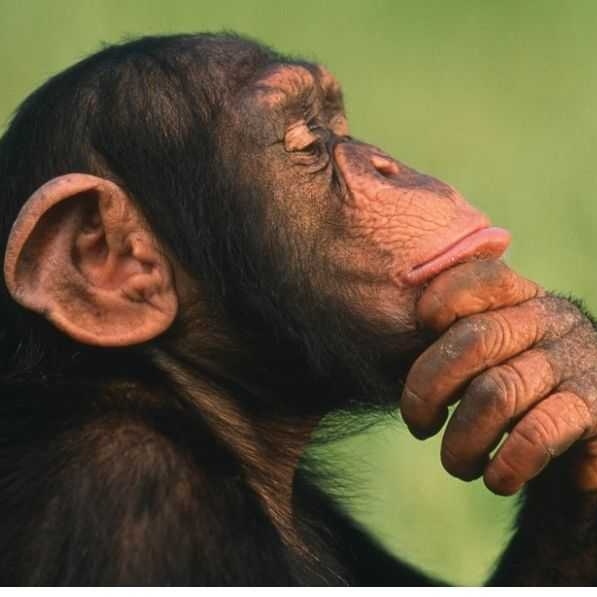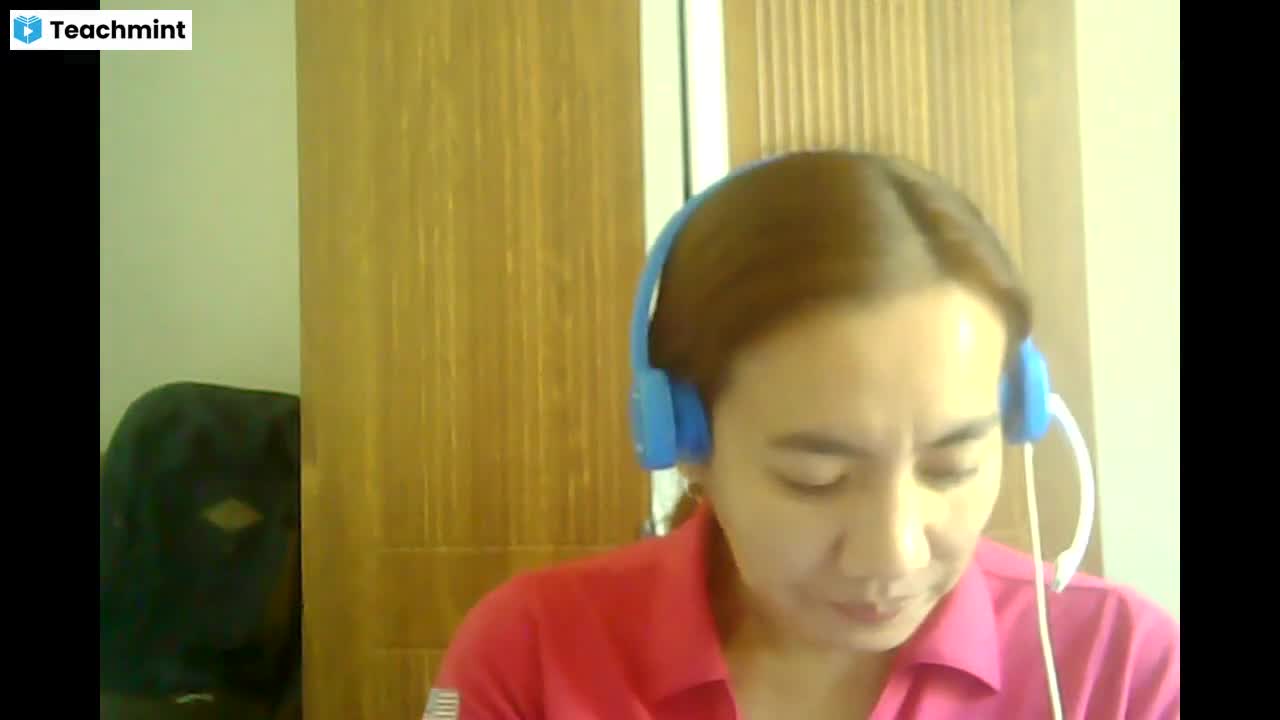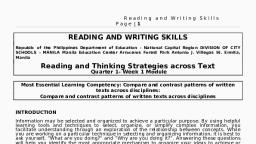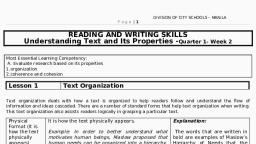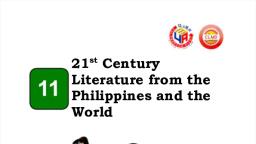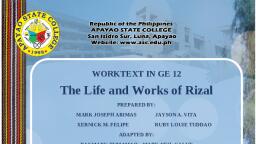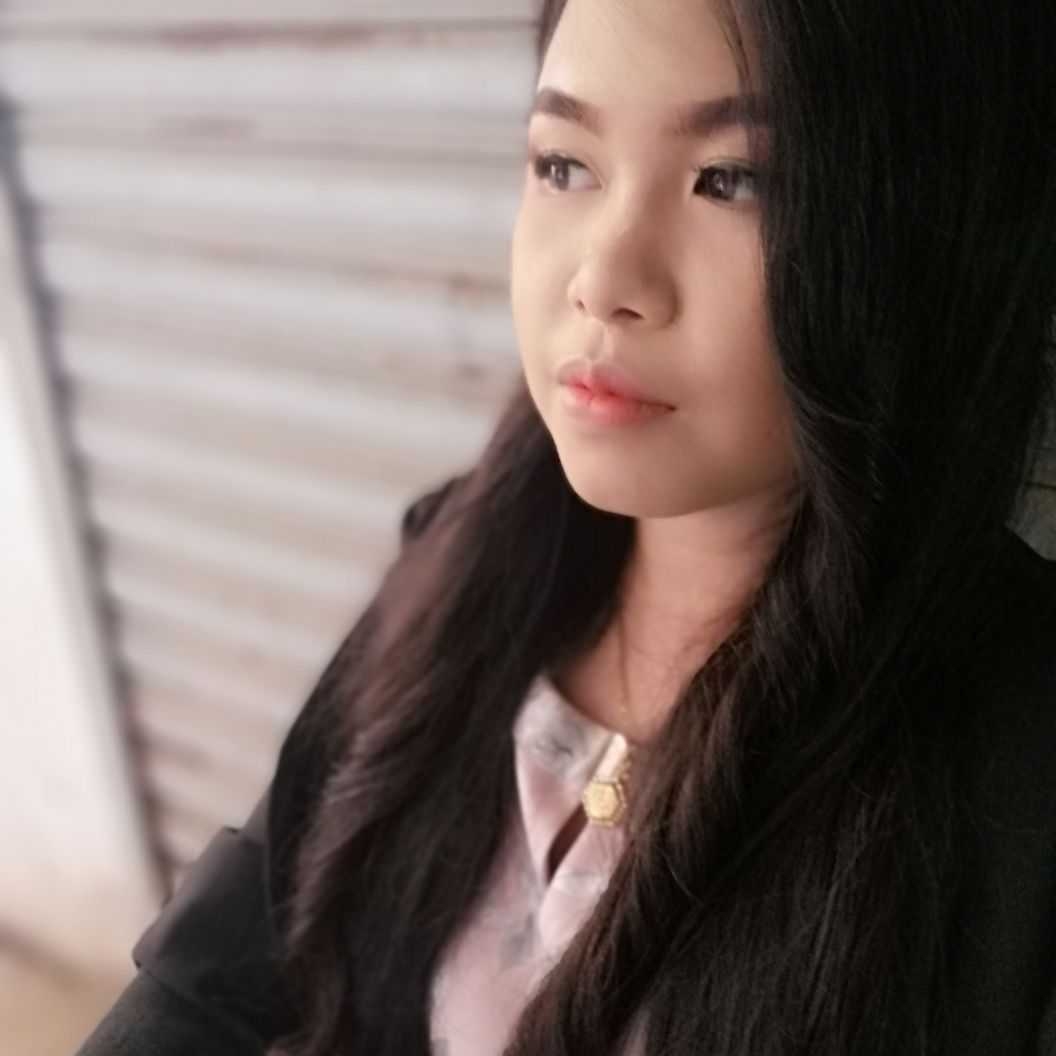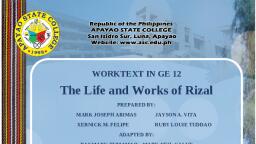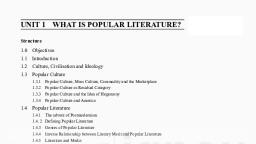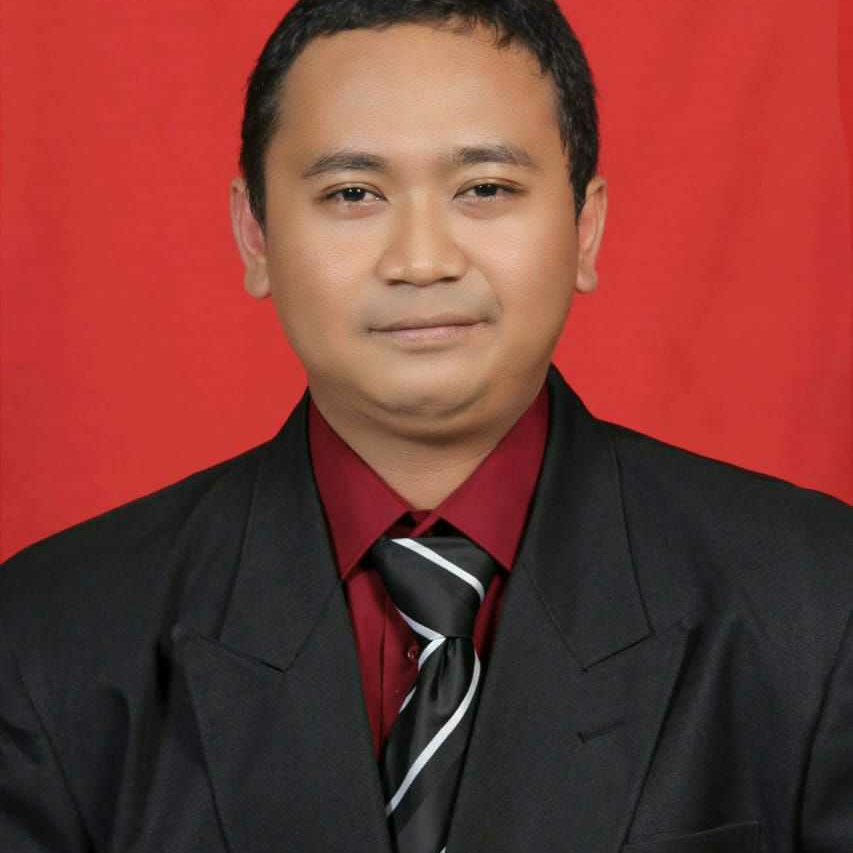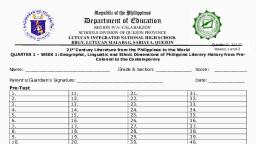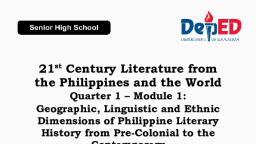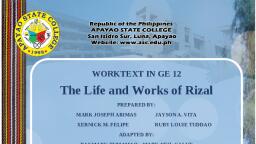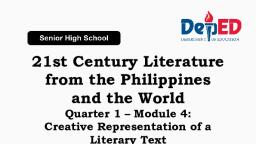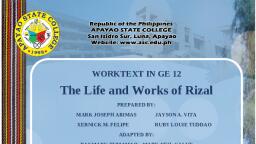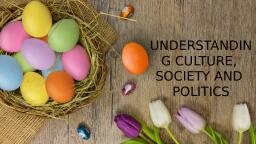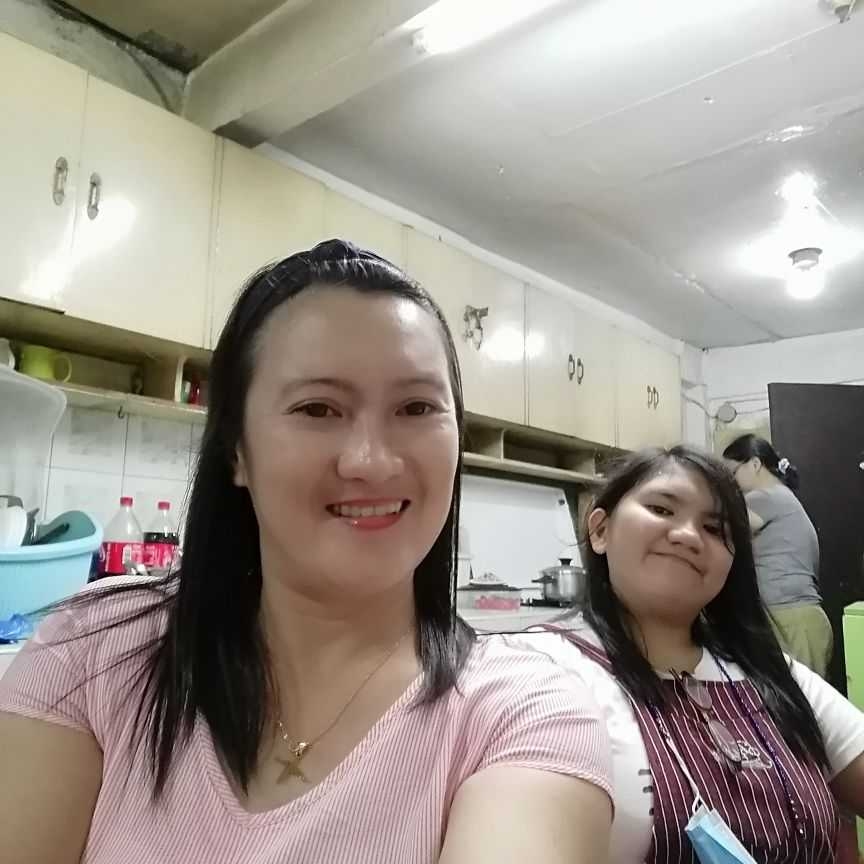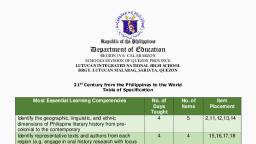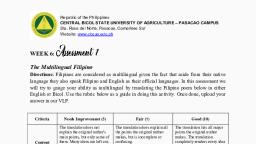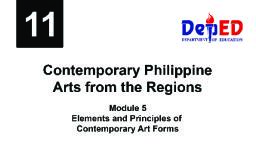Page 1 :
21st Century Literature from the Philippines and the World Quarter 1 – Module 1, Geographic, Linguistic and Ethnic Dimensions of Philippine Literary History from Pre-Colonial to the Contemporary, Reminders:, Please make this module neat. Write nothing.Compile and return at the end of the semester., Introduction, Philippine literature is as rich and diverse as the 7500 plus islands that make up our archipelago. This is not surprising considering that we have 183 living languages (ethnologue.com) across 17 regions comprised of 82 provinces. One can only imagine the many forms of artistic communication (oral or written) that have been passed on to and through generations, communities, and groups. Then and now, literature in the Philippines have come in various genres (forms) and have been appreciated and analyzed for their forms, elements, structures, and traditions., What’s New, The origin of Philippine literature can only be traced by exploring its evolution from pre-colonial up to the present. Thus, studying the past becomes imperative in understanding the literature of the present. Different genres that appeared from each period seem to reflect the place, language, culture, social and ethnic dimensions of literature produced. The nature and essence of literature has evolved over time. Traditionally, literature was strictly viewed as any form of written works especially during the 18th century. Today, its definition and scope can be considered more restrictive for there are certain standards set by some critiques before a work can be considered as a body of literature. Among the common words used by scholars and other sources that are associated to literature are excellence, expression, experience, artistry, and imagination. Its connection to human life and experiences, wherein audience can easily relate with, is the major characteristic of literature. Emerging habitually into quality literary works will help us gain better understanding of people, society, and culture., What is It, The term literature is derived from the Latin word "littera" which means "a letter of the alphabet". According to the website Britannica, literature is traditionally defined as body of written works associated to imaginative and creative works of poetry and prose and can be classified according to variety of systems such as language, national origin, historical period, genre and subject matter., Literature can either be in oral or written form. The oral literature handed down from one generation to another, then later on transformed into written form., The products of written literature are called literary text. A text can be considered literary if it has the elements of psychological characterization and chronology. Also, literature uses literary devices such as metaphor and symbolism. Reading for entertainment and learning is the most common reason why people read literature., Simply, the best way to describe the characteristics of literary text is that, it narrates a story;, it expresses feelings, thoughts, and ideas which can either be, based from the imagination or real life experiences of the author or other people; and, it delivers significant information and crosses boundaries of time, places, cultures and languages., Also, literature contains specific structure. Literary structure refers to the organizational method used in literature in which the most common type is the narrative. Parts of the narrative structure (or plot) are the exposition, rising action, climax, falling action, and resolution (denouement). In a much broader context, literary structure is not only limited to content and form but this may also refer to "the general features or characteristic of genre, style, a specific literary trend, literature as an art form, and finally, art as a whole" (The Great Soviet Encyclopedia)., For Murphy (n.d.), literary structure may involve arrangement of various elements according to purpose, style, and genre to effectively convey the intended meaning for the audience., Two Major Forms of Literature, 1. Poetry. This literary type is usually written in lines and is characterized by having the element of rhythm, sound, imagery, and form. Its main purpose is to express feelings, thoughts, and ideas. It can be divided into three types: narrative, dramatic, and lyrical poetry., a. Narrative Poetry. This poetry tells a story and has the elements of a narrative such as characters, setting, conflict, etc., b. Dramatic Poetry. This is an emotionally appealing drama written in verse that tells a story and is intended to be recited or sung in front of the audience by a character speaking in poetry., c. Lyric Poetry. It is the most common type of poetry that focuses on expressing feelings rather than telling a story., 2. Prose. In contrast to poetry, this literary piece applies a natural flow of speech and grammatical structures which are mainly consisting of complete sentences arranged logically and sequentially in a paragraph form., a. Fiction. This serves as a product of the writer's wild imagination and creative thinking where the characters react to the conflict and various issues central to the main idea of a literary work. Its three types are: short story, novel, and novella. The main genres are crime, fantasy, romance, science fiction, western, inspirational, historical fiction and horror., b. Non-fiction. These are stories inspired by real events where the writers aim to present, interpret, or describe experiences based on facts. The judgments, opinions, and commentaries of the writers may be presented in the form of essays, journals, diaries, feature articles, editorials, and the like., Genre refers to the forms of literature. The general ones are oral and written. The main types are prose and poetry. There are many other forms that have sprung through the years. Specifically, it is defined in the curriculum guide as something that “may be determined by literary technique, tone, content, or even (as in the case of fiction) length. The distinctions between genres and categories are flexible and, loosely defined, often with subgroups. The most general genres in literature are (in loose chronological order) epic, tragedy, comedy, and creative nonfiction. They can all be in the form of prose or poetry. Additionally, a genre such as satire, allegory or pastoral might appear in any of the above, not only as a sub-genre, but as a mixture of genres. Finally, they are defined by the general cultural movement of the historical period in which they were composed. Genre should not be confused with age categories, by which literature may be classified as either adult, young-adult, or children's. They also must not be confused with format, such as graphic novel or picture book.” (Glossary, Curriculum Guide), Literary elements refer “to particular identifiable characteristics of a whole text. They are not “used,” per se, by authors; they represent the elements of storytelling which are common to all literary and narrative forms. For example, every story has a theme, a setting, a conflict, and has a particular point-of-view, etc. In order to be discussed legitimately as part of a textual analysis, literary elements must be specifically identified for that particular text.” (Glossary, Curriculum Guide). The common elements of a story are setting, character, conflict, theme, point of view, and plot. Plot also has its own elements such as exposition, rising action, climax, falling action, and resolution or denouement /ˌdeɪˈnuːmɒ/. In poetry, there are four essential elements: form, imagery, rhythm, and sound. Poetry comes in different forms such as whether it is free verse, couplet, limerick, etc. Imagery on the other hand is the reason why we see pictures in words and it adds color in any types of literature especially in poetry. Rhythms and sounds are somehow similar. In fact, rhythm falls under the broad category sound. While sound deals with the common use of rhymes and other literary devices such as repetition (repeating of words, phrases, or lines), alliteration (repeating same consonant sounds), assonance (repeating same vowel sounds), and onomatopoeia (the use of the actual sound to represent someone or something), rhythm is more concerned with the flow of the beat such as whether it is fast or slow. In general, both sounds and rhythms are the key ingredients that give poetry a musical effect (Encyclopedia Britannica)., The term "Traditions" refers to the specific traits of literary works that define a generation or period in history. A literary tradition “is a collection of works that have an underlying interconnectedness and coherence that makes them more than simply a group of works sharing geography or group. Irish poetry and drama, for example, extend over several centuries, involving writers with a range of voices and preoccupations; and yet it is often thought that they are distinctively "Irish." This means that you can have someone who doesn't come from Ireland, perhaps doesn't even have Irish ancestors, but they can write in the Irish Literary Tradition because they will draw on the same references, structure, mythology, focal points for cultural meanings and historical moments.” (Glossary, Curriculum Guide), An Overview of Philippine Literature, Historically speaking, Philippine literature can be divided into three most important periods: pre-colonial, colonial, and post-colonial., All literary works produced before the Spanish colonization such as chants, proverbs, songs, and folk narratives are considered under pre-colonial period which are mostly of oral traditions. This is not because early Filipinos did not have system of writing yet but due to the unavailability of printing materials. Life was simple and so is literature during this period. If we have phones and other forms of technology to entertain us, our ancestors had literature for recreation who were noted for being music lover as more than 10 types of songs in various Philippine languages were discovered. Our forefathers also valued words of wisdom for teaching values as evidenced by numerous proverbs or salawikain. Story telling was used to explain phenomenon and to teach lessons as well. Having bugtong or riddles was also a favorite past time and listening to narratives of bravery, magic, and heroism in epics was a box office hit., The focus of literature suddenly changed upon the arrival of Spaniards. An emphasis on morality and religion was common in literary forms such as Corrido, Pasyon, and Cenaculo. The production of printed materials started but it was mostly of religious purposes and themes. It was made in an attempt to instill traditional Spanish ways and cultures among the native Filipinos. Despite this indoctrination,, native tradition still survived and flourished especially for areas where the colonial power was less popular. Literacy paved the way to develop sense of nationalism among Filipinos during the latter part of Spanish colonization. Filipinos started to write about oppression, corruption, and other social ills such as in the works of Dr. Jose P. Rizal entitled Noli Me Tangere and its sequel El Filibusterismo., The literary production during the American Period was inspired by the developments in education and culture. Knowledge and information became accessible to all Filipinos because of the free public education. During the apprenticeship period, the Filipino writers imitated English and American models. All forms of literature were explored by Filipino writers. During this period, short stories were the most prevalent literary form. With the new knowledge of English language, many writers started to gain recognition both locally and internationally like Jose Garcia Villa who earned the International title, “Poet of the Century" as an example., Philippine Literature was interrupted in its development when we were conquered by Japan between 1941-1945 since freedom of expression was uncommon back then. Filipino writers in the Philippines were forbidden to write anything against the government and only those who were in exile had the privilege to do so. As a result of banning the English language, short stories written in the vernaculars, flourished in the country., The three most influential foreign invaders to the types of literature produced during colonial periods are Spanish, American, and Japanese wherein the common themes and subject mostly tackle about oppression, religion, freedom, or anything that reflects the experiences of Filipino people under the colonizers. The influences brought to us by colonial periods are said to have been extended up to the postcolonial periods especially in social and cultural dimensions. Post-colonial is the period after the rebirth of freedom in the Philippines up to the present. One of the most unforgotten and controversial periods during this era is having Martial Law during the Marcos regime. All of the periods mentioned are essential towards understanding the types of literature being produced in the Philippines., ACTIVITIES, NOTE: Please use Yellow Paper as your answer sheet. Use bond paper for Performance task No. 3, ASSESSMENT 1a: What Have I learned so far? Answer the following questions., 1. Why is it important to learn about the pre-colonial literature of the Philippines?, 2. How does the literature during the Spanish era differ from the literature during the pre-colonial era?, 3. Which era do you think has been able to exert its influences the most? Why?, ASSESSMENT 1b: Match the literary theme on SET A to the exact period when it was written from SET B., A B, 1. sense of nationalism; oppression A. Pre-colonial Period, 2. heroic deeds; nature; supernatural B. Early Spanish Period, 3. morality; religion C. Revolutionary Period, 4. poverty; injustice; activism; social issues D. American Period, 5. longing for independence; E. Japanese Period, 6. social justice and consciousness F. Post-colonial Period, ASSESSMENT 1c: Some famous literary works in the Philippines are listed below. Identify to which type or genre each literary work belongs., A. Myth B. Essay C. Short story D. Novel E. Drama F. Epic, 1. "Biag ni Lam-ang" anonymous, 2. "Noli me Tangere" by Jose Rizal, 3. "What Is an Educated Filipino" by Francisco Benitez, 4. "Footnote to Youth" by Jose Garcia Villa, 5. "How the World Began" anonymous, ASSESSMENT 1d: Look up literary traditions that identify with each historical period below., Activity 2: Understanding the Text, Have you ever wondered why we often encounter the term "Native Filipino" when we hit the search engine about our ancestors? In the same manner, the label "Pure Filipino" is often subject for debate since we are products of interracial families., As a result of trades with our neighboring countries during ancient times and various colonial periods in the Philippine history, our identity became a major issue. The text below, taken from the Department of Tourism website, gives background about usFilipinos. It also discusses how various religions were introduced to us. Read thoroughly the selection to find out more. Be ready to answer the questions that, follow., People and Religion, Department of Tourism, 1The Filipino is basically of Malay stock with a sprinkling of Chinese, American, Spanish, and Arab blood. The Philippines has a population of 76.5 million as of May 2000, and it is hard to distinguish accurately the lines between stocks. From a long history of Western colonial rule, interspersed with the visits of merchants and traders, evolved a people of a unique blend of east and west, both in appearance and culture., 2The Filipino character is actually a little bit of all the cultures put together. The bayanihan or spirit of kinship and camaraderie that Filipinos are famous for is said to be taken from Malay forefathers. The close family relations are said to have been inherited from the Chinese. The piousness comes from the Spaniards who introduced Christianity in the 16th century. Hospitality is a common denominator in the Filipino character and this is what distinguishes the Filipino. Filipinos are probably one of the few, if not the only, English-proficient Oriental people today. Pilipino is the official national language, with English considered as the country's unofficial one., 3The Filipinos are divided geographically and culturally into regions, and each regional group is recognizable by distinct traits and dialects - the sturdy and frugal llocanos of the north, the industrious Tagalogs of the central plains, the carefree Visayans from the central islands, and the colorful tribesmen and religious Moslems of Mindanao. Tribal communities can be found scattered across the archipelago. The Philippines has more than 111 dialects spoken, owing to the subdivisions of these, basic regional and cultural groups., 4The country is marked by a true blend of cultures; truly in the Philippines, East meets West. The background of the people is Indonesian and Malay. There are Chinese and Spanish elements as well. The history of American rule and contact with merchants and traders culminated in a unique blend of East and West, both in the appearance and culture of the Filipinos, or people of the Philippines., 5Hospitality, a trait displayed by every Filipino, makes these people legendary in Southeast Asia. Seldom can you find such hospitable people who enjoy the company of their Western visitors. Perhaps due to their long association with Spain, Filipinos are emotional and passionate about life in a way that seems more Latin than Asian., 6The Spaniards introduced Christianity (the Roman Catholic faith) and succeeded in converting the overwhelming majority of Filipinos. At least 83% of the total population belongs to the Roman Catholic faith., 7The American occupation was responsible for teaching the Filipino people the English language. The Philippines is currently the third-largest English speaking country in the world., 8Historically, the Filipinos have embraced two of the great religions of the world - Islam and Christianity. Islam was introduced during the 14th century shortly after the expansion of Arab commercial ventures in Southeast Asia. Today, it is limited to the southern region of the country., 9Christianity was introduced as early as the 16th century with the coming of Ferdinand Magellan in 1521., 10Protestantism was introduced by the first Presbyterian and Methodist missionaries who arrived with the American soldiers in 1899., 11Two Filipino independent churches were organized at the turn of the century and are prominent today. These are the Aglipay (Philippine Independent Church) and the Iglesia Ni Kristo (Church of Christ) founded in 1902 and 1914, respectively. Recently the Aglipay signed a covenant with the Anglican Church. The Iglesia ni Kristo has expanded its membership considerably. Its churches, with their unique towering architecture, are landmarks in almost all important towns, provincial capitals, and major cities., ASSESSMENT 2: Do as instructed., 2a. VOCABULARY DEVELOPMENT: Define the meaning of each word based on how it is used in the paragraph given., 1. stock (paragraph 1) _______________________________________, 2. piousness (paragraph 2) _______________________________________, 3. culminated (paragraph 4) _______________________________________, 4. interspersed (paragraph 1) _______________________________________, 5. prominent (paragraph 11) _______________________________________, 2b. LET'S CHECK YOUR UNDERSTANDING: Answer each question in a complete sentence., 1. Based on the given selection, what are some foreign influences that the Filipinos inherit from various colonizers?, 2. What are some positive Filipino traits mentioned in the text?, 3. What does the expression "East meets West in the Philippines" mean?, 4. In terms of religion, how do you characterize Filipino people?, 5. What makes you proud of being a Filipino?, 6. If there is something you want to improve as a Filipino, what will it be?, 7. How are the different foreign influences reflected in the history of the, Philippine literature?, Activity 3: My Favorite Pinoy Story and Poem, Bedtime stories, legends, myths, fables and parables made our childhood life complete. We had listened to these tales when somebody shared it to us in school or at home. Who could forget those moments when our parents or teachers forced us to recite poems with embarrassing gestures? Literature has been part of us since then., ASSESSMENT 3a: Recall your most unforgettable story or poem written by a Filipino author. Write a description of its content and tell the reasons why you like it that much., ASSESSMENT 3c: Look up a Lola Basyang story or a popular local tale and identify its elements., Performance Tasks: Please write your answers legibly., If you were to write about something that pertains to the current condition of the Philippines, what would be your topic or subject about? Discuss your inspirations for choosing your topic. Answer in two to three sentences., Trace your root from both mother side and father side to create a family tree of up to three generations. Write interesting things about the origin and race of your family using creative, artistic and comprehensive graphic organizer (e.g. having Chinese relatives, etc.). Your answer can be produced using either paper (short bond paper) or digital output like using an app., Summarize what you have learned and appreciated from this module in one paragraph. Tell how this new knowledge can be applied to real-life situations., Reminders:, Please make this module neat. Write nothing.Compile and return at the end of the semester.
